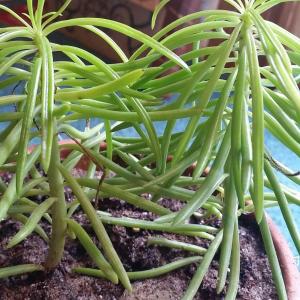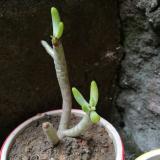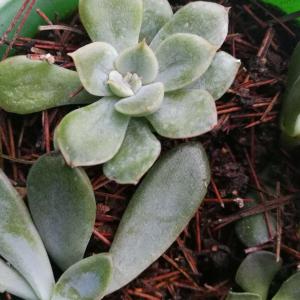文章
权问薇
2017年09月17日

#兰花 ——掰掰掰
前两天,花花去舅舅家玩,刚进屋,舅舅就拉着我去看他养的兰花,3年了,
人家的都长满了盆,他的却还是孤零零2棵,太可怜了!我灵机一动,想到了一个花农提供的妙招,——“捂芦头”(芦头既假鳞茎)赶紧教给他。

①把兰花从花盆中倒扣出来,剪掉烂根、枯根、空根、枯叶。

②找到兰花的假鳞茎,假鳞茎是兰花的养分和水分存储组织,在叶片的基部,
肉质根的上部,某些兰花的假鳞茎可以长成比较大的球形或者卵形。

③用两只手,一手捏住1个假鳞茎,然后分别向反方向扭转90度,让假鳞茎
的连接茎部分,呈现半分离的状态,注意:绝对不能完全扭断。

④在扭伤的假鳞茎连接茎部位,撒上一层多菌灵粉末消毒杀菌,或者在多菌灵、高锰酸钾或者甲基布托津等杀菌剂溶液中泡15分钟,然后拿出来晾5-10分钟。

⑤把兰花重新上盆,假鳞茎底部1厘米以下用正常的兰花植料,假鳞茎底部1厘米以上用水苔或植金石、塘基石铺0.5厘米。

⑥种完后浇次水,再把兰花放在阴凉通风的地方缓苗,缓苗成功后,正常浇水,慢慢见光每15天左右施1次复合肥或腐熟有机肥。20天左右浇点“生根剂”。

⑦这样,兰花的看芦头上就会长出好多好多的小芽,最多1个芦头能长出6个芽,就是6株兰花呦!

仙人球——砍砍砍
二姨家的仙人球,养了10年也不爆小崽,花花给她支了一招,一个月后,密密麻麻长出一堆小崽子。

①找一把锋利的刀子,用打火机或者多菌灵溶液消消毒。

②用刀子横着砍掉仙人球上半部分,砍掉部分占整个仙人球的1/3-1/2。

③把仙人球的这两部分放在散光通风的地方1-2天,晾干伤口,有条件的可以抹点多菌灵。

④仙人球砍后剩下的部分,伤口晾干后,2周以内不要沾水。之后正常养护,1个月后就会陆续爆崽啦!

⑤而砍下来的部分,晾干后,放在干净的土面上,还会生出根系,长成一株新的仙人球。

月季——拉拉拉
秋天啦,丑了一夏天的月季,终于可以再次美回来了,但是面对孤零零1、2根独杆的月季,,你是不是又失去了花开满枝的信心?别灰心,今天花花就教你几招,让你家的月季1周之内,像竹笋一样蹿芽,到时候就能赏到十朵,甚至二十几朵月季啦!
拉枝前

拉枝后

月季蹿芽、开爆盆方法1:横拉主枝
①把月季的枝条,呈90度,往两边压倒。

②用绳子、铁丝或重物固定住,让枝条保持90的状态,不至于回弹,当然也不要太重把枝条压断。

③这样原先的枝条就会失去顶端优势,1周以内,新芽就会从基部萌发出来,非常灵哦。

④小芽发的比较多的话,可以适当摘掉几个,着重发展粗壮的枝条,不要消耗太多养分。

月季蹿芽、开爆盆方法2:侧盆
①把月季枝条比较多的一侧45度,往旁边倾斜,同时,让枝条少、虚弱的一侧向上,垂直于地面。

②这样,枝条少或虚弱的一侧会形成顶端优势,萌发出很多新芽,让月季的整个株形更加丰满,枝条更多,开花也更多。

月季蹿芽、开爆盆方法3:折枝
①如果月季的一些枝条比较纤弱的话,可以把枝条在靠近下部的位置折一下。

②注意枝条不要完全折断,折断一半即可,并且要保证折断部位的下部依然有芽点哦!

③大约1周以后,折断枝条的剩余部分,就会萌发出粗壮的新芽啦!

多肉——撸撸撸
有人喜欢把多肉养成老桩?有人喜欢把多肉养成果冻?而花花最喜欢的,莫过于把多肉养到爆崽、爆盆,爆到犹如母猪生崽,能让密集恐惧症原地爆炸那种,最合我意!那到底怎么把多肉养到小崽子泛滥呢?来!花花教你点爆崽秘籍!

多头爆崽秘籍1:砍头
①经过了一个夏天,你的多肉是不是徒得不像样,丑到辣眼睛?

②不如给它个痛快!拦腰一刀,砍下来的枝条扦插,剩下的放在散光通风的地方,盆土不干不浇。

③过个2-3个星期,你会发现光秃秃的多头枝条上,就能爆出一圈小芽,萌得不要不要!

多头爆崽秘籍2:撸叶
①想让多肉,从茎干下部长出多头怎么办?简单!只要把多肉下部的叶片掰掉就行。

②从下而上,用拇指和食指捏住多肉的叶片,左右晃动,一片片轻轻掰下来。

③掰到你觉得剩下的部分好看或能看就行,然后再把多肉放在散光通风的地方正常养护就行。

④不到一个月,原先掰掉的叶片伤口上,就会密密麻麻冒出小芽子,离爆盆不远了哦!

橡皮树等木本花卉——截截截
不少花友家的橡皮树,虽然长到戳屋顶,但只有孤零零一枝独杆,难看,而正常的橡皮树,应该是呈现一把伞的形状,非常漂亮。怎么让橡皮树1杆变多杆,萌发出更多枝丫呢?简单,一把剪刀就好了啊!

如何正确截截截?
①找一把园艺剪刀,给独杆的橡皮树中间来一剪刀,拦腰截断。

②注意橡皮树的剪口要平滑,剪开后伤口会流出白色液体,这时候用撒上层草木灰,或者用塑料袋缠住就可以啦!

③大概1个月左右,短截后的橡皮树顶部就会萌发出3-5个新芽,这些新芽大小均匀,长大之后,就能形成伞的形状了。

④如果你家的橡皮树是30厘米左右的小苗,则只需剪掉最上面的顶芽,就会萌发更多侧芽啦!

矮牵牛等草本花卉——掐掐掐
别人的矮牵牛、百万小玲、栀子、茉莉、玛格丽特、满天星、天竺葵、…能开成大花球,为啥你的就只有稀稀拉拉几朵呢?关键是你的花枝条少啊!那怎么让它枝条多呢?这就需要在花的小的时候就掐掐掐(俗称摘心),让它多发芽哦!

摘心前

3次摘心后

如何正确掐掐掐?
①小苗长到8-10厘米或者4-5对叶片的时候,我们就需要给它摘心啦!

②摘的时候,用剪刀或者手指摘掉最上面的2-3对叶片,只留底部2对叶片。
 ③过1-2周后,剩下的2对叶片叶腋部位,就会萌发出4个侧芽。
③过1-2周后,剩下的2对叶片叶腋部位,就会萌发出4个侧芽。

④等到新萌发的侧芽,再长到4-5对叶片时,再掐掉顶部的2-3对叶片。

⑤这样重复2-3次,你家的花就会形成一个饱满的大花球了,到时候让花苞就会密密麻麻布满整个花球,一起绽放啦!

前两天,花花去舅舅家玩,刚进屋,舅舅就拉着我去看他养的兰花,3年了,
人家的都长满了盆,他的却还是孤零零2棵,太可怜了!我灵机一动,想到了一个花农提供的妙招,——“捂芦头”(芦头既假鳞茎)赶紧教给他。

①把兰花从花盆中倒扣出来,剪掉烂根、枯根、空根、枯叶。

②找到兰花的假鳞茎,假鳞茎是兰花的养分和水分存储组织,在叶片的基部,
肉质根的上部,某些兰花的假鳞茎可以长成比较大的球形或者卵形。

③用两只手,一手捏住1个假鳞茎,然后分别向反方向扭转90度,让假鳞茎
的连接茎部分,呈现半分离的状态,注意:绝对不能完全扭断。

④在扭伤的假鳞茎连接茎部位,撒上一层多菌灵粉末消毒杀菌,或者在多菌灵、高锰酸钾或者甲基布托津等杀菌剂溶液中泡15分钟,然后拿出来晾5-10分钟。

⑤把兰花重新上盆,假鳞茎底部1厘米以下用正常的兰花植料,假鳞茎底部1厘米以上用水苔或植金石、塘基石铺0.5厘米。

⑥种完后浇次水,再把兰花放在阴凉通风的地方缓苗,缓苗成功后,正常浇水,慢慢见光每15天左右施1次复合肥或腐熟有机肥。20天左右浇点“生根剂”。

⑦这样,兰花的看芦头上就会长出好多好多的小芽,最多1个芦头能长出6个芽,就是6株兰花呦!

仙人球——砍砍砍
二姨家的仙人球,养了10年也不爆小崽,花花给她支了一招,一个月后,密密麻麻长出一堆小崽子。

①找一把锋利的刀子,用打火机或者多菌灵溶液消消毒。

②用刀子横着砍掉仙人球上半部分,砍掉部分占整个仙人球的1/3-1/2。

③把仙人球的这两部分放在散光通风的地方1-2天,晾干伤口,有条件的可以抹点多菌灵。

④仙人球砍后剩下的部分,伤口晾干后,2周以内不要沾水。之后正常养护,1个月后就会陆续爆崽啦!

⑤而砍下来的部分,晾干后,放在干净的土面上,还会生出根系,长成一株新的仙人球。

月季——拉拉拉
秋天啦,丑了一夏天的月季,终于可以再次美回来了,但是面对孤零零1、2根独杆的月季,,你是不是又失去了花开满枝的信心?别灰心,今天花花就教你几招,让你家的月季1周之内,像竹笋一样蹿芽,到时候就能赏到十朵,甚至二十几朵月季啦!
拉枝前

拉枝后

月季蹿芽、开爆盆方法1:横拉主枝
①把月季的枝条,呈90度,往两边压倒。

②用绳子、铁丝或重物固定住,让枝条保持90的状态,不至于回弹,当然也不要太重把枝条压断。

③这样原先的枝条就会失去顶端优势,1周以内,新芽就会从基部萌发出来,非常灵哦。

④小芽发的比较多的话,可以适当摘掉几个,着重发展粗壮的枝条,不要消耗太多养分。

月季蹿芽、开爆盆方法2:侧盆
①把月季枝条比较多的一侧45度,往旁边倾斜,同时,让枝条少、虚弱的一侧向上,垂直于地面。

②这样,枝条少或虚弱的一侧会形成顶端优势,萌发出很多新芽,让月季的整个株形更加丰满,枝条更多,开花也更多。

月季蹿芽、开爆盆方法3:折枝
①如果月季的一些枝条比较纤弱的话,可以把枝条在靠近下部的位置折一下。

②注意枝条不要完全折断,折断一半即可,并且要保证折断部位的下部依然有芽点哦!

③大约1周以后,折断枝条的剩余部分,就会萌发出粗壮的新芽啦!

多肉——撸撸撸
有人喜欢把多肉养成老桩?有人喜欢把多肉养成果冻?而花花最喜欢的,莫过于把多肉养到爆崽、爆盆,爆到犹如母猪生崽,能让密集恐惧症原地爆炸那种,最合我意!那到底怎么把多肉养到小崽子泛滥呢?来!花花教你点爆崽秘籍!

多头爆崽秘籍1:砍头
①经过了一个夏天,你的多肉是不是徒得不像样,丑到辣眼睛?

②不如给它个痛快!拦腰一刀,砍下来的枝条扦插,剩下的放在散光通风的地方,盆土不干不浇。

③过个2-3个星期,你会发现光秃秃的多头枝条上,就能爆出一圈小芽,萌得不要不要!

多头爆崽秘籍2:撸叶
①想让多肉,从茎干下部长出多头怎么办?简单!只要把多肉下部的叶片掰掉就行。

②从下而上,用拇指和食指捏住多肉的叶片,左右晃动,一片片轻轻掰下来。

③掰到你觉得剩下的部分好看或能看就行,然后再把多肉放在散光通风的地方正常养护就行。

④不到一个月,原先掰掉的叶片伤口上,就会密密麻麻冒出小芽子,离爆盆不远了哦!

橡皮树等木本花卉——截截截
不少花友家的橡皮树,虽然长到戳屋顶,但只有孤零零一枝独杆,难看,而正常的橡皮树,应该是呈现一把伞的形状,非常漂亮。怎么让橡皮树1杆变多杆,萌发出更多枝丫呢?简单,一把剪刀就好了啊!

如何正确截截截?
①找一把园艺剪刀,给独杆的橡皮树中间来一剪刀,拦腰截断。

②注意橡皮树的剪口要平滑,剪开后伤口会流出白色液体,这时候用撒上层草木灰,或者用塑料袋缠住就可以啦!

③大概1个月左右,短截后的橡皮树顶部就会萌发出3-5个新芽,这些新芽大小均匀,长大之后,就能形成伞的形状了。

④如果你家的橡皮树是30厘米左右的小苗,则只需剪掉最上面的顶芽,就会萌发更多侧芽啦!

矮牵牛等草本花卉——掐掐掐
别人的矮牵牛、百万小玲、栀子、茉莉、玛格丽特、满天星、天竺葵、…能开成大花球,为啥你的就只有稀稀拉拉几朵呢?关键是你的花枝条少啊!那怎么让它枝条多呢?这就需要在花的小的时候就掐掐掐(俗称摘心),让它多发芽哦!

摘心前

3次摘心后

如何正确掐掐掐?
①小苗长到8-10厘米或者4-5对叶片的时候,我们就需要给它摘心啦!

②摘的时候,用剪刀或者手指摘掉最上面的2-3对叶片,只留底部2对叶片。
 ③过1-2周后,剩下的2对叶片叶腋部位,就会萌发出4个侧芽。
③过1-2周后,剩下的2对叶片叶腋部位,就会萌发出4个侧芽。
④等到新萌发的侧芽,再长到4-5对叶片时,再掐掉顶部的2-3对叶片。

⑤这样重复2-3次,你家的花就会形成一个饱满的大花球了,到时候让花苞就会密密麻麻布满整个花球,一起绽放啦!

1
2
文章
权问薇
2017年09月17日

换盆
1、在换盆之前,记得先停水1周,这样可以让泥土和花盆脱离。
2、将#君子兰 脱盆的时候要注意,可以一手握住君子兰的鳞茎,一手翻转花盆,把君子兰拿出来。
3、轻拍土团,先把一些比较送的土拍掉,之后用水将君子兰的根部冲洗干净。

4、观察根系,把老根、枯根、发黑的根系切除掉。

5、把根部泡在多菌灵溶液中,半个小时之后,拿出来阴干。

6、配置土壤,别忽视了这一步哦,要知道土壤配好了,养君子兰也就事半功倍了!比较合适的配比为田园土5份,腐叶土3份,河沙2份。
同时在花盆底部埋进去一些瓜子、缓释肥当做底肥。在上面盖一层3~5cm的土壤,避免根系直接接触土壤。

7、上盆之前,先用土把君子兰根系中间的部分填满,然后再上盆,注意要一边填土一边拍打花盆,避免中间出现空隙。

8、浇透水,放在阴凉通风的地方1~2天,之后拿出去晒太阳即可。

施肥
1液体肥
1、追肥要在缓根之后进行哦,记得换盆之后不要立刻进行施肥。
可以用豆饼、麻籽饼、花生饼、葵花籽、大、小麻籽等,粉粹之后浸泡在水里进行发酵,时间最好是1年以上,越长越好。
使用的时候取出来上层液体,按照1:50的比例进行配置,灌根即可,大约7~10天1次。

2、将淡水鱼,像是鲤鱼啊,鲫鱼啊之类的鳞、鳍、骨、头等,兑水浸泡使用,不过也是要发酵完全之后才能使用,这种自制花肥里含有丰富的磷钾肥,能让君子兰多开花。

3、也可以用动物的血、骨头之类的浸水发酵。
注意:液肥必须是充分发酵之后的,没有充分发酵的液体肥通常会很臭,而且还会有烧根的风险,建议最少使用发酵了1年以上的哦!

2固体肥
1、大麻籽(蓖麻籽)、小麻籽、葵花籽、芝麻等,要炒熟之后使用。建议在换盆的时候埋进盆底即可。

2、鸡粪肥等动物粪便发酵完全之后形成的肥料。追肥的时候可以在君子兰盆壁的附近挖个小孔埋进去。

3、动物血粉、动物骨粉,注意,是进行了干燥粉碎或者是焙烧粉碎之后的才能用。可以放进盆底,也可以挖个小孔当做追肥。

光照
君子兰一个夏天都在阴凉处养护,但是随着温度的降低,君子兰已经开始从休眠期中醒过来,所以,这个时候的光照就变得很重要了。
将君子兰放在隔着玻璃的南阳台上,不仅光照充足,而且玻璃能够隔绝紫外线,让君子兰能够不至于被灼伤。
同时,每隔1周的时间就要将君子兰旋转180度,为的是避免君子兰的叶片变得散乱。
浇水
君子兰的浇水也要逐渐增加,夏天大约是1周浇水1次,那么现在可以渐渐减少浇水的间隔,可以慢慢增加到5天左右浇水1次。
家里用自来水的,每次浇水之前,先把自来水放到不碍事儿的地方静置2~3的时间,去除水里的氯气。

分株
成熟的君子兰几乎每年都会在根茎处萌发幼芽,花友们可以在春天给君子兰换盆时将这些小芽分出来,养几天就又是一盆新花了!

1、把君子兰从盆中脱出,注意力度不要太大,避免损伤根系。

2、清理干净根系的泥土,观察根系。

3、把小芽小心地掰下来,最好能带着一部分根系,能提高成活率。

4、清理根系,剪掉老根、枯根、腐烂的根系。

5、把君子兰根部浸泡在在多菌灵溶液(多菌灵:水=1:2000)中20-30分钟,消毒。

6、然后拿出来君子兰,放在阴凉通风处晾干,为了安全起见,伤口处可以再涂抹一些多菌灵。

7、根部晾干后,就可以重新上盆了!
按照腐叶土:松针土:河沙=3:2:1的比例配置盆土,对于无根的小芽,要提高一下沙子的比重。

8、上盆后浇水,直到水从花盆底部的透水孔中渗出为止。
之后将君子兰放在阴凉通风处,等新叶长出后就可以正常养护了!

秋老虎
一些地区的秋老虎还没有发威,但是也不放松警惕哦!
应对秋老虎最关键的一点儿就是通风,所以一定要把君子兰放在通风好的地方啊!

1、在换盆之前,记得先停水1周,这样可以让泥土和花盆脱离。
2、将#君子兰 脱盆的时候要注意,可以一手握住君子兰的鳞茎,一手翻转花盆,把君子兰拿出来。
3、轻拍土团,先把一些比较送的土拍掉,之后用水将君子兰的根部冲洗干净。

4、观察根系,把老根、枯根、发黑的根系切除掉。

5、把根部泡在多菌灵溶液中,半个小时之后,拿出来阴干。

6、配置土壤,别忽视了这一步哦,要知道土壤配好了,养君子兰也就事半功倍了!比较合适的配比为田园土5份,腐叶土3份,河沙2份。
同时在花盆底部埋进去一些瓜子、缓释肥当做底肥。在上面盖一层3~5cm的土壤,避免根系直接接触土壤。

7、上盆之前,先用土把君子兰根系中间的部分填满,然后再上盆,注意要一边填土一边拍打花盆,避免中间出现空隙。

8、浇透水,放在阴凉通风的地方1~2天,之后拿出去晒太阳即可。

施肥
1液体肥
1、追肥要在缓根之后进行哦,记得换盆之后不要立刻进行施肥。
可以用豆饼、麻籽饼、花生饼、葵花籽、大、小麻籽等,粉粹之后浸泡在水里进行发酵,时间最好是1年以上,越长越好。
使用的时候取出来上层液体,按照1:50的比例进行配置,灌根即可,大约7~10天1次。

2、将淡水鱼,像是鲤鱼啊,鲫鱼啊之类的鳞、鳍、骨、头等,兑水浸泡使用,不过也是要发酵完全之后才能使用,这种自制花肥里含有丰富的磷钾肥,能让君子兰多开花。

3、也可以用动物的血、骨头之类的浸水发酵。
注意:液肥必须是充分发酵之后的,没有充分发酵的液体肥通常会很臭,而且还会有烧根的风险,建议最少使用发酵了1年以上的哦!

2固体肥
1、大麻籽(蓖麻籽)、小麻籽、葵花籽、芝麻等,要炒熟之后使用。建议在换盆的时候埋进盆底即可。

2、鸡粪肥等动物粪便发酵完全之后形成的肥料。追肥的时候可以在君子兰盆壁的附近挖个小孔埋进去。

3、动物血粉、动物骨粉,注意,是进行了干燥粉碎或者是焙烧粉碎之后的才能用。可以放进盆底,也可以挖个小孔当做追肥。

光照
君子兰一个夏天都在阴凉处养护,但是随着温度的降低,君子兰已经开始从休眠期中醒过来,所以,这个时候的光照就变得很重要了。
将君子兰放在隔着玻璃的南阳台上,不仅光照充足,而且玻璃能够隔绝紫外线,让君子兰能够不至于被灼伤。
同时,每隔1周的时间就要将君子兰旋转180度,为的是避免君子兰的叶片变得散乱。
浇水
君子兰的浇水也要逐渐增加,夏天大约是1周浇水1次,那么现在可以渐渐减少浇水的间隔,可以慢慢增加到5天左右浇水1次。
家里用自来水的,每次浇水之前,先把自来水放到不碍事儿的地方静置2~3的时间,去除水里的氯气。

分株
成熟的君子兰几乎每年都会在根茎处萌发幼芽,花友们可以在春天给君子兰换盆时将这些小芽分出来,养几天就又是一盆新花了!

1、把君子兰从盆中脱出,注意力度不要太大,避免损伤根系。

2、清理干净根系的泥土,观察根系。

3、把小芽小心地掰下来,最好能带着一部分根系,能提高成活率。

4、清理根系,剪掉老根、枯根、腐烂的根系。

5、把君子兰根部浸泡在在多菌灵溶液(多菌灵:水=1:2000)中20-30分钟,消毒。

6、然后拿出来君子兰,放在阴凉通风处晾干,为了安全起见,伤口处可以再涂抹一些多菌灵。

7、根部晾干后,就可以重新上盆了!
按照腐叶土:松针土:河沙=3:2:1的比例配置盆土,对于无根的小芽,要提高一下沙子的比重。

8、上盆后浇水,直到水从花盆底部的透水孔中渗出为止。
之后将君子兰放在阴凉通风处,等新叶长出后就可以正常养护了!

秋老虎
一些地区的秋老虎还没有发威,但是也不放松警惕哦!
应对秋老虎最关键的一点儿就是通风,所以一定要把君子兰放在通风好的地方啊!

1
1
文章
Dummer. ゛☀
2017年09月17日

Mealybugs are common pests of indoor plants. They can also be serious pests of outdoor plants in warmer climates, such as Florida and California.
Symptoms and Diagnosis
Adult females are oval, 1/5 to 1/3 inch long, and have a waxy, white, cottony appearance. They are slow moving and usually are in clusters along leaf veins, on the underside of leaves, and in hidden areas at joints. They are piercing-sucking insects, which feed on plant sap. The insects exude a honeydew, which can cause leaves to become sticky. Ants may be attracted to the sweet liquid. In time, a black mold, called sooty mold, can grow on the honeydew giving the leaves a dirty, sooty appearance. Plants infested with mealybugs become weak, may wilt and turn yellow, and eventually die.
Life Cycle
Indoors, eggs can be laid any time of year. Eggs hatch in about 2 weeks. The young mature in 6–8 weeks. Several generations can occur in the same year.
Integrated Pest Management Strategies
1. Remove insects. Dislodge as many insects as possible using a strong stream of water. A cotton swab soaked in rubbing alcohol will also effectively remove a few insects.
2. Use insecticidal soap. Insecticidal soaps specially formulated to kill insects and not damage plants are effective if used frequently until the problem is under control.
3. Use superior oil sprays. Highly refined oils sold as superior or horticultural oils are also very effective in controlling mealybugs. The oil suffocates the insects. Unlike dormant oils, these oils are highly refined and under proper conditions, can be applied to plants in foliage without damage. Follow label directions to avoid damage to some plants that may be sensitive. Superior oils are also considered nontoxic and are less likely to harm beneficial insects. When spraying indoors, protect surfaces that may be damaged by an oil residue.
4. Use chemical insecticides. Many insecticides registered for use indoors are available. Follow directions and, if possible, spray out-of-doors or in a garage, weather permitting.
5. To limit future problems, inspect plants regularly. With regular inspection, pest problems can be caught when just beginning and control is easier. It is also recommended to isolate newly acquired plants for 2–3 weeks to limit introducing pests indoors. Bringing plants indoors in the fall is another way of introducing insects indoors.

Symptoms and Diagnosis
Adult females are oval, 1/5 to 1/3 inch long, and have a waxy, white, cottony appearance. They are slow moving and usually are in clusters along leaf veins, on the underside of leaves, and in hidden areas at joints. They are piercing-sucking insects, which feed on plant sap. The insects exude a honeydew, which can cause leaves to become sticky. Ants may be attracted to the sweet liquid. In time, a black mold, called sooty mold, can grow on the honeydew giving the leaves a dirty, sooty appearance. Plants infested with mealybugs become weak, may wilt and turn yellow, and eventually die.

Life Cycle
Indoors, eggs can be laid any time of year. Eggs hatch in about 2 weeks. The young mature in 6–8 weeks. Several generations can occur in the same year.
Integrated Pest Management Strategies
1. Remove insects. Dislodge as many insects as possible using a strong stream of water. A cotton swab soaked in rubbing alcohol will also effectively remove a few insects.
2. Use insecticidal soap. Insecticidal soaps specially formulated to kill insects and not damage plants are effective if used frequently until the problem is under control.

3. Use superior oil sprays. Highly refined oils sold as superior or horticultural oils are also very effective in controlling mealybugs. The oil suffocates the insects. Unlike dormant oils, these oils are highly refined and under proper conditions, can be applied to plants in foliage without damage. Follow label directions to avoid damage to some plants that may be sensitive. Superior oils are also considered nontoxic and are less likely to harm beneficial insects. When spraying indoors, protect surfaces that may be damaged by an oil residue.
4. Use chemical insecticides. Many insecticides registered for use indoors are available. Follow directions and, if possible, spray out-of-doors or in a garage, weather permitting.

5. To limit future problems, inspect plants regularly. With regular inspection, pest problems can be caught when just beginning and control is easier. It is also recommended to isolate newly acquired plants for 2–3 weeks to limit introducing pests indoors. Bringing plants indoors in the fall is another way of introducing insects indoors.
0
0
文章
Dummer. ゛☀
2017年09月17日

Thrips are minute, slender-bodied insects less than 1/16 inch to about 3/16 inch in length. With magnification, you can identify the adults that range in color from yellow to black and have four long, narrow, fringed wings. The young nymphs are smaller, wingless, and range in color from yellow to white. Many thrips are plant feeders attacking flowers, leaves, fruit, twigs, or buds.
Symptoms and Diagnosis
Thrips congregate by the hundreds and leave black, varnish-like fecal deposits on the underside of leaves. To feed, they puncture the epidermal layer of the host plant with their single large mandible, then slurp the cell sap as it flows into the wound. As a result of their feeding, the foliage appears dusty or silver and dull. Some species may burrow between the upper and lower leaf surfaces to feed. Blossoms can become streaked with brown and can wither prematurely. Injured leaves are twisted or discolored and scarred. The fruit of host plants is often pitted. A few species are beneficial predators of mites and small insects including other thrips, and some feed on fungal spores. Several species may bite people. Some species act as vectors of plant disease. Thrips are poor fliers, so that damage may first appear in one location and then slowly spread over the plant. Thrips will be most apparent on flowers, especially white, yellow, and other light-colored blooms.
Life Cycle
Eggs are inserted into leaves, fruit, stems, or the bark of trees and shrubs. One to two weeks later, pale, wingless nymphs emerge and feed actively until they pupate. Some species enclose the pupa in a cocoon on the ground or on the host plant. The winged adult thrips emerge from the cocoon or pupal stage. Generations may occur every two to three weeks, but the largest populations are present from late spring to midsummer. Thrips overwinter in the egg stage.
Integrated Pest Management Strategies
1. Knock off thrips with a forceful spray of cold water in small gardens, preferably early in the morning. Use a nozzle that produces a fine spray of water, and thoroughly wash off the undersides of affected leaves. The control is most effective when repeated at least 3 times, either daily or every other day.
2. Keep plants well irrigated and adequately misted since thrips prefer a dry environment.
3. Prune and destroy injured and infested plants. Do not compost them.
4. Predacious spiders, mites, and pirate bugs help control thrips. Conserving naturally occurring populations of beneficial insects by avoiding persistent pesticides is important to biologically controlling thrips.
5. Aluminum foil and other disorienting mulches have been used with some success to reduce thrips infestations.
6. Two applications of pyrethrum applied 3 to 4 days apart will treat serious infestations.
7. Insecticidal soaps are effective for temporary reduction of thrips populations. Spray every 3 days for 2 weeks. To control iris thrips, spray insecticidal soap at the base of each plant every 5 to 7 days until the infestation has been controlled. To prevent thrips problems, soak iris divisions and gladiolus corms for 30 minutes in a hot water bath (110–125 degrees F). Dig up gladiolus bulbs early in the fall and let them cure in open trays in a shady location with good air flow such as a garage for a few weeks before soaking them. Then allow the bulbs to dry thoroughly before storing.
8. Spray infested plants with a systemic insecticide such as imidacloprid (Merit) since thrips frequently burrow inside the plant tissue.
9. If necessary, use chemical insecticides such as acephate (Orthene), bifenthrin, imidacloprid, or spinosad. Spray 2 or more times at intervals of 7-10 days to control thrips as they hatch.

Symptoms and Diagnosis
Thrips congregate by the hundreds and leave black, varnish-like fecal deposits on the underside of leaves. To feed, they puncture the epidermal layer of the host plant with their single large mandible, then slurp the cell sap as it flows into the wound. As a result of their feeding, the foliage appears dusty or silver and dull. Some species may burrow between the upper and lower leaf surfaces to feed. Blossoms can become streaked with brown and can wither prematurely. Injured leaves are twisted or discolored and scarred. The fruit of host plants is often pitted. A few species are beneficial predators of mites and small insects including other thrips, and some feed on fungal spores. Several species may bite people. Some species act as vectors of plant disease. Thrips are poor fliers, so that damage may first appear in one location and then slowly spread over the plant. Thrips will be most apparent on flowers, especially white, yellow, and other light-colored blooms.

Life Cycle
Eggs are inserted into leaves, fruit, stems, or the bark of trees and shrubs. One to two weeks later, pale, wingless nymphs emerge and feed actively until they pupate. Some species enclose the pupa in a cocoon on the ground or on the host plant. The winged adult thrips emerge from the cocoon or pupal stage. Generations may occur every two to three weeks, but the largest populations are present from late spring to midsummer. Thrips overwinter in the egg stage.

Integrated Pest Management Strategies
1. Knock off thrips with a forceful spray of cold water in small gardens, preferably early in the morning. Use a nozzle that produces a fine spray of water, and thoroughly wash off the undersides of affected leaves. The control is most effective when repeated at least 3 times, either daily or every other day.
2. Keep plants well irrigated and adequately misted since thrips prefer a dry environment.
3. Prune and destroy injured and infested plants. Do not compost them.
4. Predacious spiders, mites, and pirate bugs help control thrips. Conserving naturally occurring populations of beneficial insects by avoiding persistent pesticides is important to biologically controlling thrips.

5. Aluminum foil and other disorienting mulches have been used with some success to reduce thrips infestations.
6. Two applications of pyrethrum applied 3 to 4 days apart will treat serious infestations.
7. Insecticidal soaps are effective for temporary reduction of thrips populations. Spray every 3 days for 2 weeks. To control iris thrips, spray insecticidal soap at the base of each plant every 5 to 7 days until the infestation has been controlled. To prevent thrips problems, soak iris divisions and gladiolus corms for 30 minutes in a hot water bath (110–125 degrees F). Dig up gladiolus bulbs early in the fall and let them cure in open trays in a shady location with good air flow such as a garage for a few weeks before soaking them. Then allow the bulbs to dry thoroughly before storing.

8. Spray infested plants with a systemic insecticide such as imidacloprid (Merit) since thrips frequently burrow inside the plant tissue.
9. If necessary, use chemical insecticides such as acephate (Orthene), bifenthrin, imidacloprid, or spinosad. Spray 2 or more times at intervals of 7-10 days to control thrips as they hatch.
0
0
文章
Dummer. ゛☀
2017年09月16日

Japanese beetles are 3/8" (8-11 mm) long and ¼" (5-7 mm) wide, brilliant metallic green insects with copper-brown wings whose hard body makes them unpalatable to many predators, including birds. To distinguish them from other metallic green or copper-colored beetles, the diagnostic sign is a row of 5 small tufts of white hairs under the wing covers on each side and a 6th pair at the tip of the abdomen. The larvae, called grubs, are grayish-white with a dark brown head. They are C-shaped when disturbed. The 1st instar (stage of an insect or arthropod between molts) is 1/16” (1.5 mm) long and the 3rd instar is 1¼” (32mm) long. They are found in the soil where they feed on the tender roots of vegetables, lawn grasses, and other plants.
Life Cycle
Japanese beetles overwinter as a partially grown grub in the soil below the frost line. The grubs resume feeding on grass roots in the spring, and then pupate near the soil surface. Adults emerge between May and July, depending on their geographic location . Adults live 30-45 days and feed, usually in groups, first on low-growing plants and then on tree leaves, working from the top of the plants downward. After feeding and mating, each female lays 1-5 eggs at a time before again feeding and mating until a total of 40-60 eggs are laid 2-4” under the soil surface in grassy areas. Most are laid by mid-August. The eggs hatch after 8-14 days, and the young grubs feed on fine grass roots until cold weather drives them below the frost line. Most are in the 3rd instar by this time. In spring the grubs come to the surface, continuing their development and forming a pupa in an earthen cell 1-3" deep in the soil.
Japanese beetle adults are active for about 6 weeks in the summer. Since adult beetle damage is primarily aesthetic, control is not essential for survival of ornamental plants. Because they are strong fliers and frequently move about, by season’s end, adults are capable of having traveled many miles from where they lived as grubs. As a result, local beetle control does not insure less grub damage to lawns. Likewise, local grub control will not necessarily prevent adult damage to garden plants.
Integrated Pest Management Strategies:
1. Hand-pick adult beetles. If only a few adults are present, shake plants early in the morning (~ 7 a.m.) when they are sluggish. They should be collected and dropped into a container of soapy water. Any beetles or damaged leaves will attract more insects and should be removed..
2. Pheromone traps. Research has found that pheromone traps attract many more beetles than they catch and probably do more harm than good to plants in the beetles’ flight path and near the traps. Their use is not recommended.
3. Use insecticides if necessary. To control adults, one of two very safe pesticide, pyrethrum or Neem, can be applied in two applications, 3 to 4 days apart, to control the problem. If something stronger is needed, carbaryl (Sevin) may be used (every 5-10 days during heavy infestation) with monitoring for mites or aphids, in which case acephate (Orthene; more toxic) or malathion should be used. Other insecticides include Turcam, Closure (bendiocarb), permethrin, and synthetic pyrethroids. With any insecticide, efficacy will be decreased if there is heavy rainfall shortly after application of the chemical.
To control grubs present in damaging numbers, newer chemicals, Merit (imidacloprid) and MACH2 (halofenozide), applied in June and July 20 days before anticipated Japanese beetle adult egg-laying activity, have enough residual to kill new grubs coming to the soil surface to feed in late July through August. It is important to apply evenly over all the ground and to water in well. These chemicals will also be effective on other grub species when applied at the appropriate times.
4. Biological controls. The hard body of the beetle makes them unpalatable to many predators, such as birds. However, toads, moles, shrews, and skunks are known to feed on the beetles.
To control grubs, bacterial milky spore disease (Paenibacillus popillae, formerly known as Bacillus popillae) can be applied as a dust for Japanese beetle grub control and must be ingested by the grub to be effective. Once inside the digestive tract; spores reproduce within the grub, eventually turning it an opaque milky white before killing it. Spores then disperse into the surrounding soil and can persist for many years, but do not spread until live hosts are present. The more grubs, the faster it spreads. Milky spore infects only Japanese beetle grubs and has no effect on beneficial organisms. Its efficacy is questionable and the spore count has to build up for 2-3 years, during which time no insecticides may be used. More research needs to be done.
Other biological controls are parasitic nematodes that need to be applied when the grubs are small, with irrigation before and after application. Species of Heterorhabditis are said to be more effective than strains of Steinernema carpocapsae.
5. Use trap crops. When practical, crops which are highly favored by Japanese beetles can be used to draw the adults away from other crops. Trap crops include: borage, white geraniums, grape vines, evening primroses, and zinnias. The beetles can be collected or killed on the trap crops. This method provides early detection and can limit the amount of spray needed to control the insects.
6. Select resistant plants. Among trees and shrubs are: ash, dogwood, American elder, shagbark hickory, holly, red and silver maple, oaks, pear, white poplar, sweet gum, and tulip tree; euonymus and common lilac.
Avoid planting the most susceptible plants: roses, grapes, and rose of Sharon; apple and crabapple, mountain ash, grey birch, American and horse chestnut, elm, linden, Japanese and Norway maple, London plane tree, Lombardy poplar, Prunus (cherry, etc.), sassafras, and black walnut.

Life Cycle
Japanese beetles overwinter as a partially grown grub in the soil below the frost line. The grubs resume feeding on grass roots in the spring, and then pupate near the soil surface. Adults emerge between May and July, depending on their geographic location . Adults live 30-45 days and feed, usually in groups, first on low-growing plants and then on tree leaves, working from the top of the plants downward. After feeding and mating, each female lays 1-5 eggs at a time before again feeding and mating until a total of 40-60 eggs are laid 2-4” under the soil surface in grassy areas. Most are laid by mid-August. The eggs hatch after 8-14 days, and the young grubs feed on fine grass roots until cold weather drives them below the frost line. Most are in the 3rd instar by this time. In spring the grubs come to the surface, continuing their development and forming a pupa in an earthen cell 1-3" deep in the soil.

Japanese beetle adults are active for about 6 weeks in the summer. Since adult beetle damage is primarily aesthetic, control is not essential for survival of ornamental plants. Because they are strong fliers and frequently move about, by season’s end, adults are capable of having traveled many miles from where they lived as grubs. As a result, local beetle control does not insure less grub damage to lawns. Likewise, local grub control will not necessarily prevent adult damage to garden plants.
Integrated Pest Management Strategies:
1. Hand-pick adult beetles. If only a few adults are present, shake plants early in the morning (~ 7 a.m.) when they are sluggish. They should be collected and dropped into a container of soapy water. Any beetles or damaged leaves will attract more insects and should be removed..

2. Pheromone traps. Research has found that pheromone traps attract many more beetles than they catch and probably do more harm than good to plants in the beetles’ flight path and near the traps. Their use is not recommended.
3. Use insecticides if necessary. To control adults, one of two very safe pesticide, pyrethrum or Neem, can be applied in two applications, 3 to 4 days apart, to control the problem. If something stronger is needed, carbaryl (Sevin) may be used (every 5-10 days during heavy infestation) with monitoring for mites or aphids, in which case acephate (Orthene; more toxic) or malathion should be used. Other insecticides include Turcam, Closure (bendiocarb), permethrin, and synthetic pyrethroids. With any insecticide, efficacy will be decreased if there is heavy rainfall shortly after application of the chemical.

To control grubs present in damaging numbers, newer chemicals, Merit (imidacloprid) and MACH2 (halofenozide), applied in June and July 20 days before anticipated Japanese beetle adult egg-laying activity, have enough residual to kill new grubs coming to the soil surface to feed in late July through August. It is important to apply evenly over all the ground and to water in well. These chemicals will also be effective on other grub species when applied at the appropriate times.
4. Biological controls. The hard body of the beetle makes them unpalatable to many predators, such as birds. However, toads, moles, shrews, and skunks are known to feed on the beetles.
To control grubs, bacterial milky spore disease (Paenibacillus popillae, formerly known as Bacillus popillae) can be applied as a dust for Japanese beetle grub control and must be ingested by the grub to be effective. Once inside the digestive tract; spores reproduce within the grub, eventually turning it an opaque milky white before killing it. Spores then disperse into the surrounding soil and can persist for many years, but do not spread until live hosts are present. The more grubs, the faster it spreads. Milky spore infects only Japanese beetle grubs and has no effect on beneficial organisms. Its efficacy is questionable and the spore count has to build up for 2-3 years, during which time no insecticides may be used. More research needs to be done.

Other biological controls are parasitic nematodes that need to be applied when the grubs are small, with irrigation before and after application. Species of Heterorhabditis are said to be more effective than strains of Steinernema carpocapsae.
5. Use trap crops. When practical, crops which are highly favored by Japanese beetles can be used to draw the adults away from other crops. Trap crops include: borage, white geraniums, grape vines, evening primroses, and zinnias. The beetles can be collected or killed on the trap crops. This method provides early detection and can limit the amount of spray needed to control the insects.

6. Select resistant plants. Among trees and shrubs are: ash, dogwood, American elder, shagbark hickory, holly, red and silver maple, oaks, pear, white poplar, sweet gum, and tulip tree; euonymus and common lilac.
Avoid planting the most susceptible plants: roses, grapes, and rose of Sharon; apple and crabapple, mountain ash, grey birch, American and horse chestnut, elm, linden, Japanese and Norway maple, London plane tree, Lombardy poplar, Prunus (cherry, etc.), sassafras, and black walnut.
0
0
求助
Katrina
2017年09月16日

My Senecio Vitalis (Blue Chalk Fingers) plant keeps having limbs shrivel and die! Please help! I keep it out of direct sunlight and only water it every 3 to 4 days depending on need. I just separated the roots of the two plants and repoted a week ago.


0
0
sunnyzou:maybe you hurt the roots when you repotting. no direct sunlight until they recovered growth.
Ueca:I know this sounds somewhat counter-intuitive, but try giving it a bit more sunlight.
文章
Miss Chen
2017年09月16日

相关图片

分布与危害
锈病是红花上重要病害,全国各种植区广泛发生,造成不同程度损失。
症状
主要危害叶片和苞叶。苗期染病子叶、下胚轴及根部密生黄色病斑,大小5-10×2-3(mm),其中密生针头状黄色颗粒状物,即病菌性子器。后期在锈子器边缘产生栗褐色近圆形斑点,即锈子器,表皮破裂后散出锈孢子。成株叶片染病叶背散生栗褐色至锈褐色或暗褐色稍隆起的小疱状物,即病菌的夏孢子堆,大小0.5-1mm。疮斑表皮破裂后,孢子堆周围表皮向上翻卷,逸出大量棕褐色夏孢子,有时叶片正面也可产生夏孢子堆。进入发病后期,夏孢子堆处生出暗褐色至黑褐色疱状物,即病菌的冬孢子堆,大小1-1.5mm。严重时叶面上孢子堆满布,叶片枯黄,病株常较健株提早15天枯死。
病原
Pucciniacarthami(Hutz.)Corda称#红花柄锈菌 ,属担子菌亚门真菌。性孢子器球形,蜜黄色,顶端突出在寄主表皮外,大小90-150×80-140(μm);性孢子卵圆形,单胞无色,大小2.7-5.0×2.4-3.6(μm)。性孢子成熟时从性子器孔口排出,呈蜜露状。锈孢子器栗褐色,近圆形至条状,产生黄褐色锈孢子,圆形至椭圆形,表生微刺,大小22-32×2l-26(μm)。夏孢子黄褐色至浅茶褐色,球形至广椭圆形,球形,表面生微刺,大小22-29×22-26(μm)。冬孢子褐色至茶褐色,双胞,椭圆形,表面生瘤状小突起,有短柄,大小31.7-41.5×21.5-26.8(μm)。冬孢子萌发温限10-35℃,25℃最适。夏孢子在干燥时能存活166天。
发生规律
红花锈菌系长循环型单主寄生锈菌。病菌以冬孢子随病残体遗留在田间或粘附在种子上越冬,翌春冬孢子萌发产虫担孢子引起初侵染。西北红花春播区,3月下旬播种的,30天后子叶、下胚轴及根部出现性子器,5-6天产生锈孢子器,锈孢子侵入叶片,5月下旬叶斑上产生夏孢子堆;夏孢子又通过风雨传播引致再侵染,8月中旬植株衰老产生冬孢子堆和冬孢子越冬。该病一般在6月中旬开始流行,其流行程度取决于5-8月的雨量和浇水次数。
防治方法
(1)因地制宜选育和种植抗病或早熟避病的品种。
(2)加强栽培管理。
选择高燥地块种植红花,出苗30天左右,间苗时注意拔除病株,尽量减少浇水次数,严格控制灌水量,雨后及时排水,防止湿气滞留,适当增施磷钾肥或草木灰,增强抗病力。
(3)种子处理。
播种前用种子重量0.2%-0.4%的15%三唑酮拌种。
(4)药剂防治。
发病初期喷洒25%三唑酮可湿性粉剂1000倍液或国光黑杀(12.5%烯唑醇)2500-3000倍液、70%代森锰锌可湿性粉剂500倍液、波美0.3°石硫合剂。对上述杀菌剂产生抗药性时,可改用25%丙环唑乳油3000倍液或40%杜邦福星乳油9000-10000倍。

分布与危害
锈病是红花上重要病害,全国各种植区广泛发生,造成不同程度损失。
症状
主要危害叶片和苞叶。苗期染病子叶、下胚轴及根部密生黄色病斑,大小5-10×2-3(mm),其中密生针头状黄色颗粒状物,即病菌性子器。后期在锈子器边缘产生栗褐色近圆形斑点,即锈子器,表皮破裂后散出锈孢子。成株叶片染病叶背散生栗褐色至锈褐色或暗褐色稍隆起的小疱状物,即病菌的夏孢子堆,大小0.5-1mm。疮斑表皮破裂后,孢子堆周围表皮向上翻卷,逸出大量棕褐色夏孢子,有时叶片正面也可产生夏孢子堆。进入发病后期,夏孢子堆处生出暗褐色至黑褐色疱状物,即病菌的冬孢子堆,大小1-1.5mm。严重时叶面上孢子堆满布,叶片枯黄,病株常较健株提早15天枯死。
病原
Pucciniacarthami(Hutz.)Corda称#红花柄锈菌 ,属担子菌亚门真菌。性孢子器球形,蜜黄色,顶端突出在寄主表皮外,大小90-150×80-140(μm);性孢子卵圆形,单胞无色,大小2.7-5.0×2.4-3.6(μm)。性孢子成熟时从性子器孔口排出,呈蜜露状。锈孢子器栗褐色,近圆形至条状,产生黄褐色锈孢子,圆形至椭圆形,表生微刺,大小22-32×2l-26(μm)。夏孢子黄褐色至浅茶褐色,球形至广椭圆形,球形,表面生微刺,大小22-29×22-26(μm)。冬孢子褐色至茶褐色,双胞,椭圆形,表面生瘤状小突起,有短柄,大小31.7-41.5×21.5-26.8(μm)。冬孢子萌发温限10-35℃,25℃最适。夏孢子在干燥时能存活166天。
发生规律
红花锈菌系长循环型单主寄生锈菌。病菌以冬孢子随病残体遗留在田间或粘附在种子上越冬,翌春冬孢子萌发产虫担孢子引起初侵染。西北红花春播区,3月下旬播种的,30天后子叶、下胚轴及根部出现性子器,5-6天产生锈孢子器,锈孢子侵入叶片,5月下旬叶斑上产生夏孢子堆;夏孢子又通过风雨传播引致再侵染,8月中旬植株衰老产生冬孢子堆和冬孢子越冬。该病一般在6月中旬开始流行,其流行程度取决于5-8月的雨量和浇水次数。
防治方法
(1)因地制宜选育和种植抗病或早熟避病的品种。
(2)加强栽培管理。
选择高燥地块种植红花,出苗30天左右,间苗时注意拔除病株,尽量减少浇水次数,严格控制灌水量,雨后及时排水,防止湿气滞留,适当增施磷钾肥或草木灰,增强抗病力。
(3)种子处理。
播种前用种子重量0.2%-0.4%的15%三唑酮拌种。
(4)药剂防治。
发病初期喷洒25%三唑酮可湿性粉剂1000倍液或国光黑杀(12.5%烯唑醇)2500-3000倍液、70%代森锰锌可湿性粉剂500倍液、波美0.3°石硫合剂。对上述杀菌剂产生抗药性时,可改用25%丙环唑乳油3000倍液或40%杜邦福星乳油9000-10000倍。
0
1
文章
Dummer. ゛☀
2017年09月15日

Found in all apple-growing areas of the world, the codling moth (Cydia pomonella) is considered to be one of the most destructive pests of apples. Adults are gray to brown moths with a 3/4 inch wingspan. They have a chocolate-colored patch at the tip of each forewing and coppery transverse markings.
Codling moth larvae are pink or creamy white caterpillars with mottled brown heads that tunnel through apples directly to the core. As they feed, they push out mounds of fecal material, called frass, which gathers around the entrance hole. Damage lowers the market value of the fruit and makes it unfit for human consumption. Alternate host plants include pears, crabapples, walnuts and stone fruits.
Note: The codling moth was introduced to North America by the colonists more than 200 years ago and is now one of the leading pests in home orchards.
Life Cycle
Full grown larvae pass through the winter in a cocoon beneath loose bark or in orchard litter. Pupation takes place in the spring. Moths begin emerging about the time that apple trees are in bloom and lay an average of 50 to 60 eggs on leaves, twigs and fruits. Once eggs hatch the larvae feed briefly on leaves, then damage fruit by boring into the centers. Larvae feed for three weeks, then leave to seek a suitable place to spin cocoons. There are two generations per year.
Control
Scrape loose bark in early spring to remove overwintering cocoons and then spray All Seasons® horticultural oil to eradicate eggs and first generation early instar stages.
Beneficial nematodes are microscopic, worm-like parasites that actively hunt, penetrate and destroy immature stages of this pest. Spray on trunks and main branches, and also over the soil out to the drip line for a 60% to 90% mortality in pre-pupae.
Use pheromone traps to determine the peak flight period for moths, then release trichogramma wasps to attack eggs. Pheromone traps will also help reduce male moths where populations are low and trees are isolated.
Surround WP — a wettable kaolin clay — can be used to deter a broad range of fruit tree pests (and diseases), and will reduce codling moth damage by 50-60%. Apply before moths arrive and continue for 6-8 weekly applications, or until the infestation is over.
In areas of severe infestation, spray plant-derived insecticides when 75% of petals have fallen, followed by three sprays at 1-2 week intervals. These natural pesticides have fewer harmful side effects than synthetic chemicals and break down more quickly in the environment.

Codling moth larvae are pink or creamy white caterpillars with mottled brown heads that tunnel through apples directly to the core. As they feed, they push out mounds of fecal material, called frass, which gathers around the entrance hole. Damage lowers the market value of the fruit and makes it unfit for human consumption. Alternate host plants include pears, crabapples, walnuts and stone fruits.
Note: The codling moth was introduced to North America by the colonists more than 200 years ago and is now one of the leading pests in home orchards.

Life Cycle
Full grown larvae pass through the winter in a cocoon beneath loose bark or in orchard litter. Pupation takes place in the spring. Moths begin emerging about the time that apple trees are in bloom and lay an average of 50 to 60 eggs on leaves, twigs and fruits. Once eggs hatch the larvae feed briefly on leaves, then damage fruit by boring into the centers. Larvae feed for three weeks, then leave to seek a suitable place to spin cocoons. There are two generations per year.
Control
Scrape loose bark in early spring to remove overwintering cocoons and then spray All Seasons® horticultural oil to eradicate eggs and first generation early instar stages.
Beneficial nematodes are microscopic, worm-like parasites that actively hunt, penetrate and destroy immature stages of this pest. Spray on trunks and main branches, and also over the soil out to the drip line for a 60% to 90% mortality in pre-pupae.

Use pheromone traps to determine the peak flight period for moths, then release trichogramma wasps to attack eggs. Pheromone traps will also help reduce male moths where populations are low and trees are isolated.
Surround WP — a wettable kaolin clay — can be used to deter a broad range of fruit tree pests (and diseases), and will reduce codling moth damage by 50-60%. Apply before moths arrive and continue for 6-8 weekly applications, or until the infestation is over.

In areas of severe infestation, spray plant-derived insecticides when 75% of petals have fallen, followed by three sprays at 1-2 week intervals. These natural pesticides have fewer harmful side effects than synthetic chemicals and break down more quickly in the environment.
0
0

















